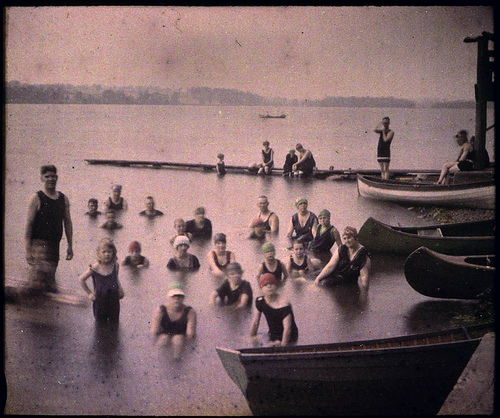
Photography’s earliest practitioners dreamed of finding a method for reproducing the world around them in color. Some nineteenth-century photographers experimented with chemical formulations aimed at producing color images by direct exposure, while others applied paints and powders to the surfaces of monochrome prints. Vigorous experimentation led to several early color processes, some of which were even patented, but the methods were often impractical, cumbersome and unreliable.

After decades of wishing for a practical color process, photographers were thrilled when Auguste and Louis Lumière announced the invention of the autochrome process. The Lumière brothers, inventors of the motion picture camera, presented their invention to the French Academy of Sciences in 1904. The process used a screen of tiny potato starch grains dyed orange-red, green and violet. Dusted onto a glass plate, the dyed grains were covered with a layer of sensitive panchromatic silver bromide emulsion. As light entered the camera, it was filtered by the dyed grains before it reached the emulsion. While the exposure time was very long, the plate could be processed easily by a photographer familiar with standard darkroom procedures. The result was a unique, realistic, positive color image on glass that required no further printing.
George Eastman House has significant holdings of autochromes, including over 3900 examples by amateur photographer Charles Zoller of Rochester, New York. The museum also holds autochromes by Edward Steichen among others.
General information about the George Eastman House Photography Collection is available at https://www.eastmanhouse.org/inc/collections/photography.php.
For information on obtaining reproductions go to: https://www.eastmanhouse.org/flickr/index.php.
view profile
Alison, Curator of Photographs says:
No handcoloring….it’s an autochrome, a complicated early color process using microscopic grains of potato starch which had been dyed orange, green and violet and embedded in pine pitch, beeswax or a combination of the two on a piece of glass which was also coated with light sensitive silver halide emulsion. (There was also lampblack to fill in the spaces between starch grains and a final shellac coat to the plate) The different colored starch grains functioned as color filters. The finished picture remains on the glass and was viewed with back lighting, which accounts for the luminosity of these images and the slight graininess of the starch makes for a pointillist or impressionist effect. IMO they are among the most beautiful of photographic technologies, but the color is not stable, the images fade easily when exposed to light and when easier processes came along, the autochrome more or less disappeared. We have thousands of them at Eastman House that we never exhibit because of their fragility. So happy we can share them with you this way.
Edited version-
US NAVY Woman


